
eleeye
ElephantEye - a XiangQi (Chinese Chess) Engine for XQWizard with Strong AI
Stars: 314
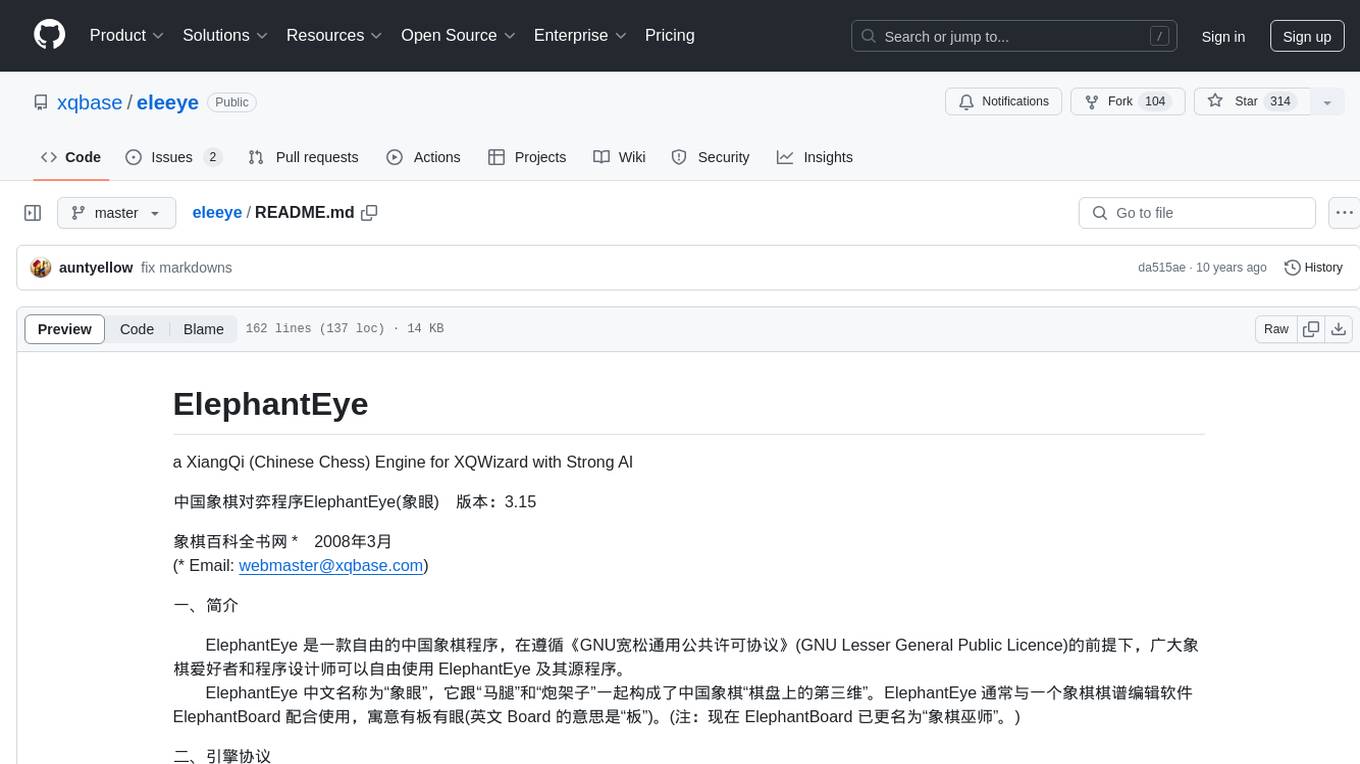
ElephantEye is a free Chinese Chess program that follows the GNU Lesser General Public Licence. It is designed for chess enthusiasts and programmers to use freely. The program works as a XiangQi engine for XQWizard with strong AI capabilities. ElephantEye supports UCCI 3.0 protocol and offers various parameter settings for users to customize their experience. The program uses brute-force chess algorithms and static position evaluation techniques to search for optimal moves. ElephantEye has participated in computer chess competitions and has been tested on various online chess platforms. The source code of ElephantEye is available on SourceForge for developers to explore and improve.
README:
a XiangQi (Chinese Chess) Engine for XQWizard with Strong AI
中国象棋对弈程序ElephantEye(象眼) 版本:3.15
象棋百科全书网 * 2008年3月
(* Email: [email protected])
一、简介
ElephantEye 是一款自由的中国象棋程序,在遵循《GNU宽松通用公共许可协议》(GNU Lesser General Public Licence)的前提下,广大象棋爱好者和程序设计师可以自由使用 ElephantEye 及其源程序。
ElephantEye 中文名称为“象眼”,它跟“马腿”和“炮架子”一起构成了中国象棋“棋盘上的第三维”。ElephantEye 通常与一个象棋棋谱编辑软件ElephantBoard 配合使用,寓意有板有眼(英文 Board 的意思是“板”)。(注:现在 ElephantBoard 已更名为“象棋巫师”。)
二、引擎协议
ElephantEye 支持UCCI 3.0,浅红象棋用户可通过UCCI引擎适配器(UCCI2QH)调用ElephantEye引擎。
(1) 支持的UCCI命令有:
ucci
setoption ...
position {fen <fen_str> | startpos} [moves <move_list>]
banmoves <move_list>
go [ponder | draw] ...
ponderhit [draw] | stop
probe {fen <fen_str> | startpos} [moves <move_list>]
quit
(2) 可以返回的UCCI信息有:
id {name <engine_name> | version <version_name> | copyright <copyright_info> | author <author_name> | user <user_name>}
option ...
ucciok
info ...
{nobestmove | bestmove <best_move> [ponder <ponder_move>] [draw | resign]}
pophash [bestmove <best_move>] [lowerbound <value> depth <depth>] [upperbound <value> depth <depth>]
bye
三、参数设置
ElephantEye 作为UCCI引擎,有若干可以设置的参数(可以直接在<象棋巫师>中设置)。
(1) 开局库:
默认的开局库为 ElephantEye 程序(ELEEYE.EXE)当前目录下的 BOOK.DAT,含有10,000个对称局面的着法。
(2) 思考时间:
限定思考深度通常不是很好的选择,建议给定限时让程序自动分配时间。而在解杀局或分析局面时,则可让程序无限制思考,并可随时中止思考。
(3) 置换表大小:
尽管置换表大小对程序的运行速度影响不大,默认16MB的设置已经足够,但 ElephantEye 还是提供了设置置换表大小的功能。在内存允许的情况下,下慢棋时可以适当增加置换表的大小,但建议不要超过物理内存的一半。
(3) 裁剪程度:
为加快程序的运算速度,ElephantEye 默认使用空着裁剪,并且产生负面影响的可能性很小。只有最低级别会禁用空着裁剪。
(4) 知识量:
知识量和局面评价的准确性有关,在 ElephantEye 的知识量等级中,只有最低级别是不采用局面评价函数的(只考虑子力价值),在解排局等不需要依靠审局知识来分析的局面时,可以尝试用这种设置。
(5) 随机性:
ElephantEye 设有4级随机性。随机性越大,程序越有可能走出它认为不是最好的着法,但“不是最好的着法”并非一点好处也没有,尤其在没有启用开局库时,适当增大随机性,可以避免程序在相同的局面下走出一样的着法。
四、规则
从2.0版开始,ElephantEye除了支持“单方面长将判负”的规则外,还支持“长打判负”,“打”包括“将”和“捉”。由于程序复杂性方面的限制,只有以下三种情况被识别成“捉”:
A. 马捉车或有根的炮兵(卒);
B. 车捉有根的马炮兵(卒);
C. 炮捉车或有根的马兵(卒)。
尽管 ElephantEye 在复杂的情况可能无法正确识别长打,但由于支持UCCI命令 banmoves ... ,一旦用户认为引擎走了“长打”的禁着,可以用<象棋巫师>的“设置禁着”功能让引擎强制变着。
五、博弈算法
ElephantEye 属于偏向蛮力的象棋程序,使用了严谨而有效的博弈算法:
(1) 使用位行和位列的着法生成器:
位行(BitRanks)和位列(BitFiles)有利于滑动棋子(车和炮)的着法(尤其是吃子着法)生成,位行和位列可以用查表来代替在射线上做的循环运算。在ElephantEye 中,位行和位列的技术不仅用在着法生成器中,也用到了牵制的判断上。
(2) 静态局面搜索:
在做静态搜索时,ElephantEye 搜索了吃子或解将的着法,在搜索吃子着法时,ElephantEye 过滤掉不重要的吃子,例如吃不过河的兵、吃不处于防守中的士象等着法,都不在静态搜索的范围之内。
(3) 循环着法和长将检测:
ElephantEye 可以识别循环着法,出现循环着法时可以判断哪方为长将,并且会利用禁止长将的规则来谋求优势,但目前 ElephantEye 还无法识别长捉。
(4) 置换表:
ElephantEye 参考了中国象棋程序“纵马奔流”的设计思路,使用深度优先和始终覆盖的双层置换表,并采用低出(高出)边界修正的置换表更新策略。
(5) 带检验的空着裁剪:
ElephantEye 使用 R=2 的空着裁剪,在残局阶段使用带检验的空着裁剪。
(6) 迭代加深/吃子着法/杀手着法/历史表启发:
ElephantEye 的着法排序非常简单清晰,依次是迭代加深着法、好的吃子着法、杀手着法和按历史表排序的生成着法。
(7) 将军/唯一应将延伸:
在选择性延伸上,ElephantEye 采用了将军和唯一应将延伸。
(8) Alpha-Beta主要变例搜索:
ElephantEye 使用传统意义上的递归式Alpha-Beta主要变例搜索。
(9) 开局库:
ElephantEye 的开局库共包含了10,000个对称着法,是从1990年到2005年全国象棋个人赛、团体赛、五羊杯、联赛等8,000局顶尖比赛中提取的。
(10) 后台思考和时间分配策略:
ElephantEye 支持后台思考功能,同时提供了时段制和加时制两种时间分配策略,会自动合理分配时间。
六、开局库
ElephantEye 的开局库可由“ElephantEye 开局库制作工具”制作。运行制作工具后,首先要选择PGN棋谱所在的文件夹,然后保存为开局库文件(通常是 BOOK.DAT)。通常,用来生成开局库的棋谱数量越多,生成的开局库文件就越大。
为了使制作的开局库对 ElephantEye 生效,只需要把生成的开局库文件替换掉 ElephantEye 目录下的 BOOK.DAT 即可,也可以在<象棋巫师>的“引擎设置”对话框中指定开局库文件。
七、局面评价函数库
ElephantEye 从2.1版开始,程序的搜索部分和局面评价部分就分离了,搜索部分通过调用API函数的形式与局面评价部分耦合。
其他象棋程序设计师可以在 ElephantEye 的基础上更自由地发挥。根据LGPL协议,搜索和局面评价这两个部分都作为独立的程序库,运用其中任何一部分都只需要公开该部分的源程序即可。换句话说,如果局面评价部分没有使用任何开放代码,那么程序设计师就没有义务公开这部分的源程序,搜索部分也是如此。
ElephantEye 的局面评价API函数接口定义如下:
A. 局面评价引擎名称:const char *GetEngineName(void);
B. 局面预评价函数接口:void PreEvaluate(PositionStruct *lppos, PreEvalStruct *lpPreEval);
C. 局面评价函数接口:int Evaluate(const PositionStruct *lppos, int vlAlpha, int vlBeta);
其中 PositionStruct 和 PreEvalStruct 必须分别符合 position.h 和 pregen.h 中定义的结构。
八、源程序
ElephantEye 的源程序包括9个模块,内容大致为:
(1) ucci.h/ucci.cpp
UCCI命令解释模块,包括 Windows 和 Unix 下的行输入接收程序;
(2) pregen.h/pregen.cpp
Zobrist 数组和着法预置表的生成模块。ElephantEye 的预置表分两个部分,一是滑动棋子的着法预置表(包括不吃子、车吃子、炮吃子和隔两子吃子),它是实现位行和位列技术的基础;二是其他棋子的着法预置表,使得着法生成时避免了烦琐的边界判断。
(3) position.h/position.cpp
主要描述着法和局面的数据结构及功能。局面的处理是本模块的重点,处理内容包括局面初始化、FEN串导入、棋子移动、杀手着法的合理性判断、将军判断、长将和循环检测、子力价值分调整等过程,还包括5个子力位置价值表。
(4) genmoves.cpp
着法生成器,包括生成吃子着法和生成不吃子着法的两个,但不能只生成解除将军的着法。在生成吃子着法的同时赋予每个着法以相应的MVV(LVA)(或称准SEE)值。该模块还有一个专门判断棋子是否有保护的函数,来计算MVV(LVA)值,对于有保护的棋子,计算MVV-LVA的值(小于零不计),对于无保护的棋子,只计算MVV的值。因此,判断棋子是否有根的程序也包括在本模块中。
(5) hash.h/hash.cpp
置换表、历史表和着法列表管理模块,包括置换表的分配和存取、主要变例获取等操作。
(6) book.h/book.cpp
开局库读取模块。
(7) movesort.h/movesort.cpp
着法列表排序模块。
(8) search.h/search.cpp
搜索模块,除了静态搜索、完全搜索和根结点搜索这三个主要过程外,还包括迭代加深控制、后台思考、时间分配、搜索参数统计和搜索信息输出等内容。该模块是整个程序的核心模块。
(9) eleeye.cpp
主程序(即 main 函数)。
(10) preeval.h/preeval.cpp
子力位置数组预生成器,ElephantEye 根据“进攻/防守”和“开局/中局/残局”两个参数线性调整子力位置数组。
(11) evaluate.cpp
局面评价函数,ElephantEye 采用了四级偷懒评价的机制,最粗的层次只评价特殊棋型,进一层次评价牵制,再进一层次评价车的灵活性,最高层次还评价马的阻碍。
九、程序表现
ElephantEye 的设计重点在搜索算法,但在知识上比较欠缺。在2.8GHz的处理器上每秒可搜索约1,000,000个结点(包括常规搜索和静态搜索),一般的中局局面在1分钟内可搜索约11层。
在棋力上,ElephantEye 和“棋隐”、SaoLa (象棋挑战者)等程序具有同等水平,但由于局面评估函数上的缺陷,ElephantEye 距离顶尖的商业象棋软件(谢谢大师、象棋世家、象棋奇兵、棋天大圣等)尚有一定的差距。
ElephantEye 在联众、弈天等象棋对弈网站上作过测试,用等级分来衡量,联众网的战绩在2500分左右,弈天网快棋的战绩在2000分左右,慢棋在1500分左右。
2005年9月在台湾象棋软件爱好者施金山先生的帮助下,ElephantEye 参加了在台北举行的第10届ICGA电脑奥林匹克大赛中国象棋组比赛,战绩是7胜5和14负,在14个程序中排名第11;2006年8月 ElephantEye 参加了在北京举行的全国首届计算机博弈锦标赛,战绩是7胜2和11负,在18个程序中排名第7。
十、相关资源
ElephantEye的源程序发布在SourceForge的XiangQi Wizard项目中,其页面是:
http://sourceforge.net/projects/xqwizard/
ElephantEye的版本改进,实时同步地发布在SourceForge的SVN站点上,获取地址是:
https://xqwizard.svn.sourceforge.net/svnroot/xqwizard/
您可以使用 TortoiseSVN 等SVN客户端程序获取到最新的(跟开发者完全同步的)代码,TortoiseSVN 的使用介绍和下载地址是:
http://sourceforge.net/projects/tortoisesvn/
ElephantEye 必须在支持UCCI(如<象棋巫师>)的象棋程序下运行,<象棋巫师>安装程序包含了最近一个版本的 ElephantEye。
<象棋巫师>可到下列站点下载:
http://www.skycn.com/soft/24665.html (天空软件站)
http://www.onlinedown.net/soft/38287.htm (华军软件园)
ElephantEye 的源程序包除了 ElephantEye 本身的源程序外,还包括以下几个附加模块:
(1) 基础代码(base):提供了汇编指令、系统函数调用等功能;
(2) 中国象棋规则模块(cchess):为其他软件使用 ElephantEye 代码提供了接口;
(3) 开局库制作模块(BOOK):制作开局库BOOK.DAT的代码;
(4) UCCI引擎联赛模拟器(LEAGUE):为UCCI引擎测试和比赛提供了自动批量对局的平台;
(5) UCCI引擎搜索树分析器(TREE):UCCI引擎(支持UCCI 2.2+)的搜索路线分析工具;
(6) XQF棋谱工具(XQFTOOLS):提供XQF等多种棋谱转换为PGN的工具;
(7) 浅红象棋适配器(UCCI2QH):为浅红象棋调用UCCI引擎提供了接口;
(8) 浅红象棋引擎支持UCCI的适配器(QH2UCCI):为“梦入神蛋”浅红象棋加入UCCI引擎测试提供了接口;
(9) BBS Chess(BBSCHESS):一个用 Visual Basic 制作的国际象棋局面设置工具,可在各高校BBS上粘贴彩色的国际象棋局面;
(10) 棋盘图片生成器(FEN2BMP):一个可以把国际象棋和中国象棋的FEN文件转换成BMP文件的实用工具;
(11) 编码转换(codec),包括简繁转码、UNIX文本转码、Base64转码等;
(12) 其他工具(MISC):包括简易网络通讯、管道测试等工具;
(13) 说明文档(DOC):即《中国象棋程序设计探索》系列连载;
(14) 参赛棋谱(CCGC):ElephantEye 参加首届全国计算机博弈锦标赛(CCGC)的全部棋谱。
如果要获得关于 ElephantEye 的更加详细的信息,可登录象棋百科全书网:
http://www.xqbase.com/
For Tasks:
Click tags to check more tools for each tasksFor Jobs:
Alternative AI tools for eleeye
Similar Open Source Tools

eleeye
ElephantEye is a free Chinese Chess program that follows the GNU Lesser General Public Licence. It is designed for chess enthusiasts and programmers to use freely. The program works as a XiangQi engine for XQWizard with strong AI capabilities. ElephantEye supports UCCI 3.0 protocol and offers various parameter settings for users to customize their experience. The program uses brute-force chess algorithms and static position evaluation techniques to search for optimal moves. ElephantEye has participated in computer chess competitions and has been tested on various online chess platforms. The source code of ElephantEye is available on SourceForge for developers to explore and improve.
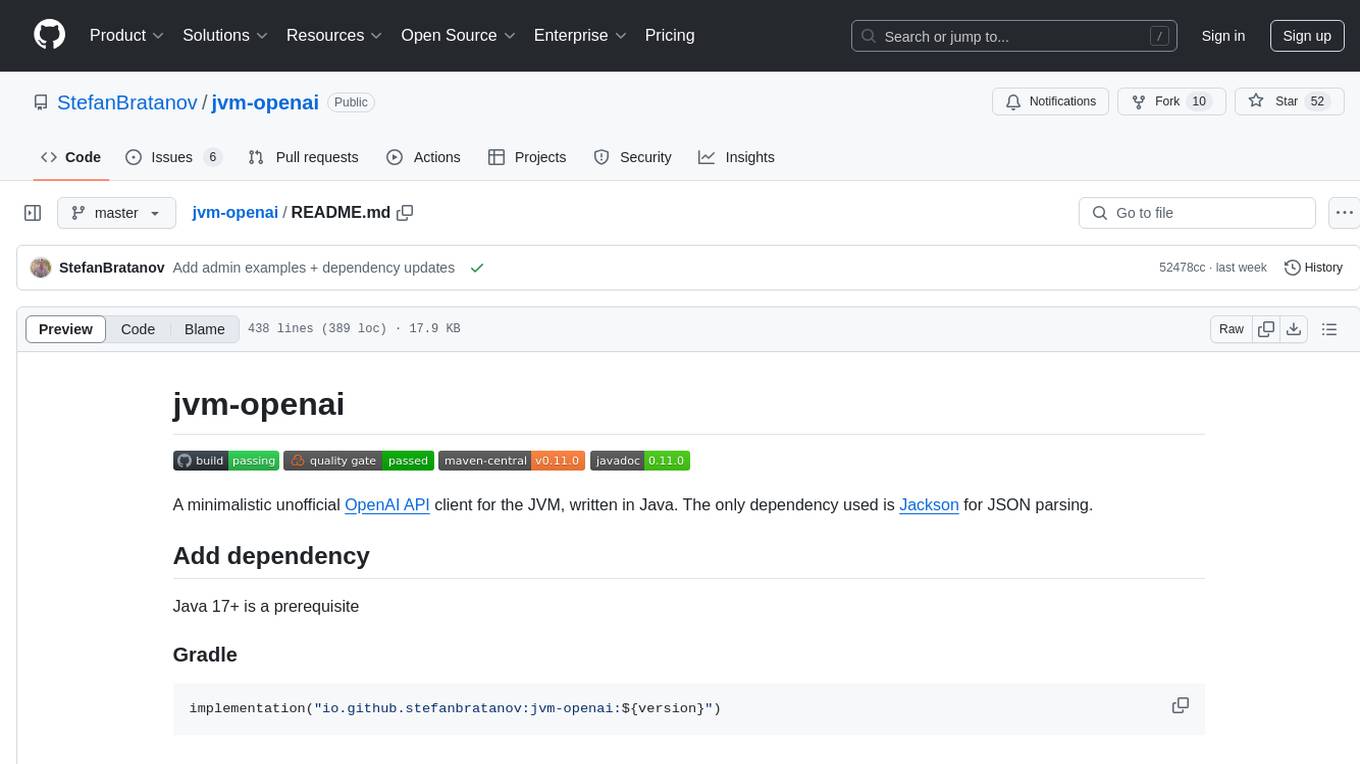
jvm-openai
jvm-openai is a minimalistic unofficial OpenAI API client for the JVM, written in Java. It serves as a Java client for OpenAI API with a focus on simplicity and minimal dependencies. The tool provides support for various OpenAI APIs and endpoints, including Audio, Chat, Embeddings, Fine-tuning, Batch, Files, Uploads, Images, Models, Moderations, Assistants, Threads, Messages, Runs, Run Steps, Vector Stores, Vector Store Files, Vector Store File Batches, Invites, Users, Projects, Project Users, Project Service Accounts, Project API Keys, and Audit Logs. Users can easily integrate this tool into their Java projects to interact with OpenAI services efficiently.
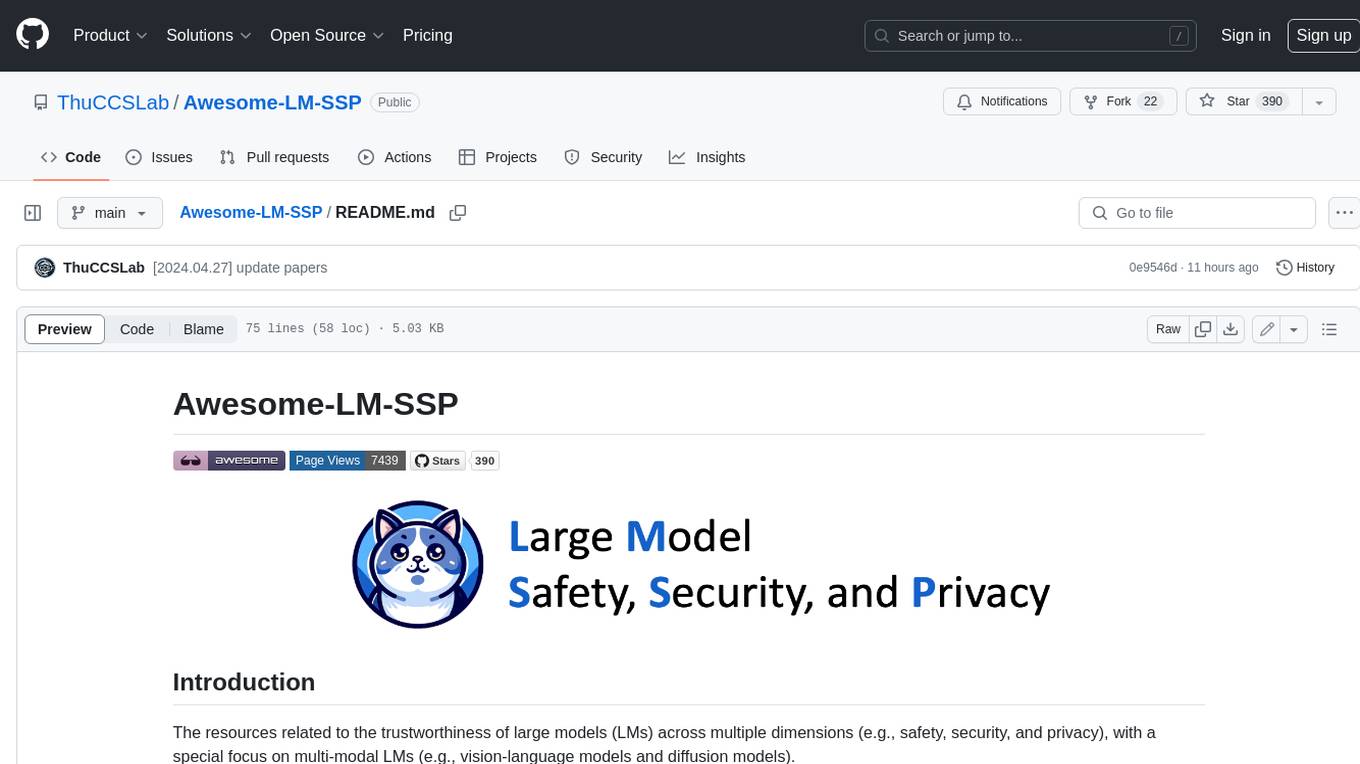
Awesome-LM-SSP
The Awesome-LM-SSP repository is a collection of resources related to the trustworthiness of large models (LMs) across multiple dimensions, with a special focus on multi-modal LMs. It includes papers, surveys, toolkits, competitions, and leaderboards. The resources are categorized into three main dimensions: safety, security, and privacy. Within each dimension, there are several subcategories. For example, the safety dimension includes subcategories such as jailbreak, alignment, deepfake, ethics, fairness, hallucination, prompt injection, and toxicity. The security dimension includes subcategories such as adversarial examples, poisoning, and system security. The privacy dimension includes subcategories such as contamination, copyright, data reconstruction, membership inference attacks, model extraction, privacy-preserving computation, and unlearning.
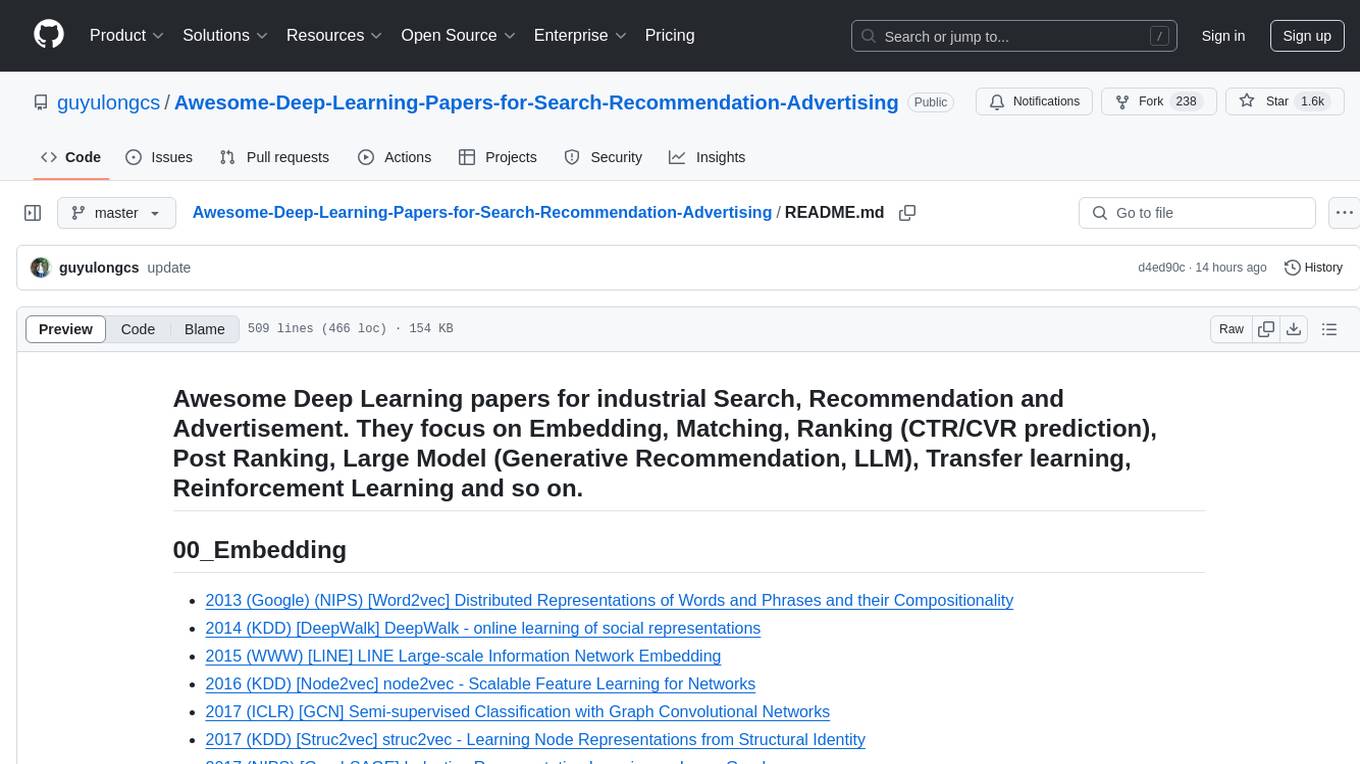
Awesome-Deep-Learning-Papers-for-Search-Recommendation-Advertising
This repository contains a curated list of deep learning papers focused on industrial applications such as search, recommendation, and advertising. The papers cover various topics including embedding, matching, ranking, large models, transfer learning, and reinforcement learning.
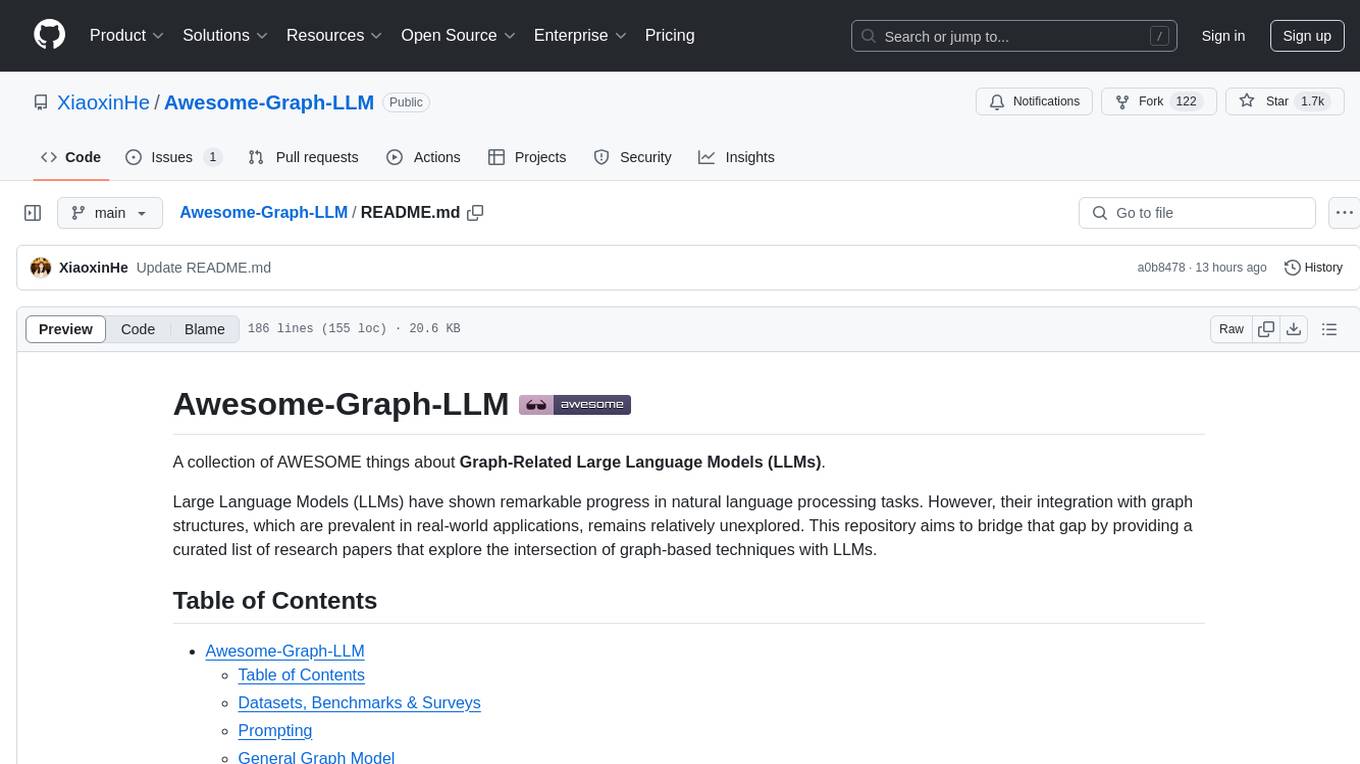
Awesome-Graph-LLM
Awesome-Graph-LLM is a curated collection of research papers exploring the intersection of graph-based techniques with Large Language Models (LLMs). The repository aims to bridge the gap between LLMs and graph structures prevalent in real-world applications by providing a comprehensive list of papers covering various aspects of graph reasoning, node classification, graph classification/regression, knowledge graphs, multimodal models, applications, and tools. It serves as a valuable resource for researchers and practitioners interested in leveraging LLMs for graph-related tasks.
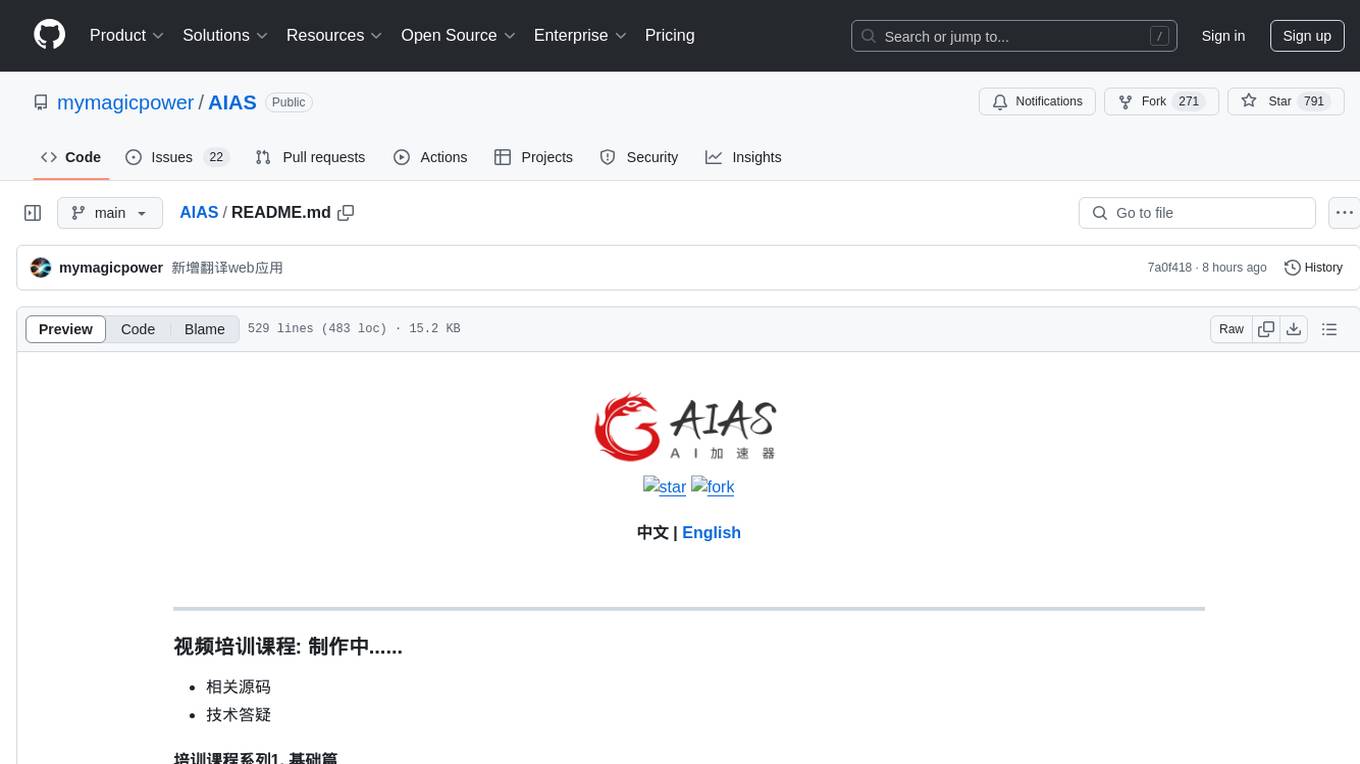
AIAS
AIAS is a comprehensive AI training platform that offers courses and practical examples in various AI fields such as traditional image processing, deep learning algorithms, JavaAI applications, NLP, web development, image generation, and desktop application development. The platform also provides SDKs for tasks like image recognition, OCR, natural language processing, audio processing, video analysis, and big data analysis. Users can access training materials, source code, and tools for developing AI applications across different domains.
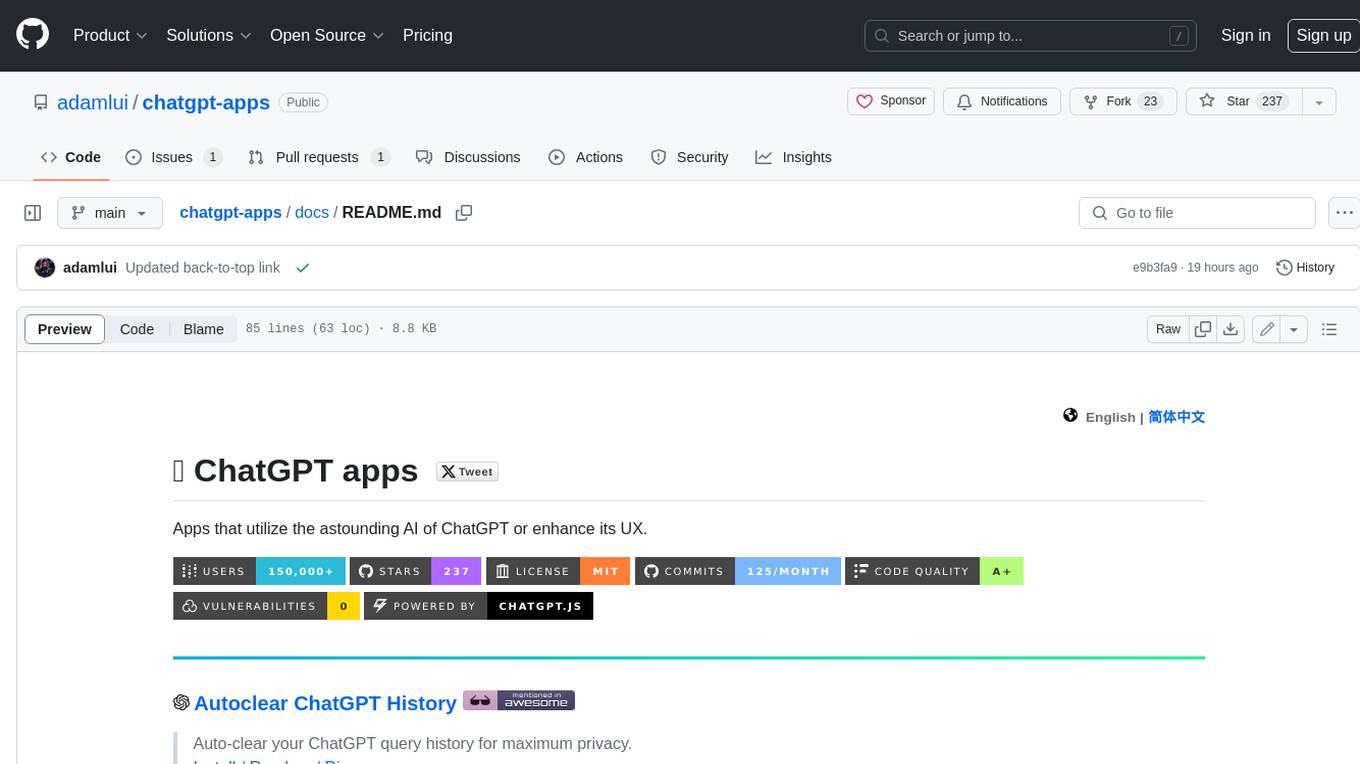
chatgpt-apps
This repository contains a collection of apps that utilize the astounding AI of ChatGPT or enhance its UX. These apps range from simple scripts to full-fledged extensions, each designed to make your ChatGPT experience more efficient, enjoyable, or private.
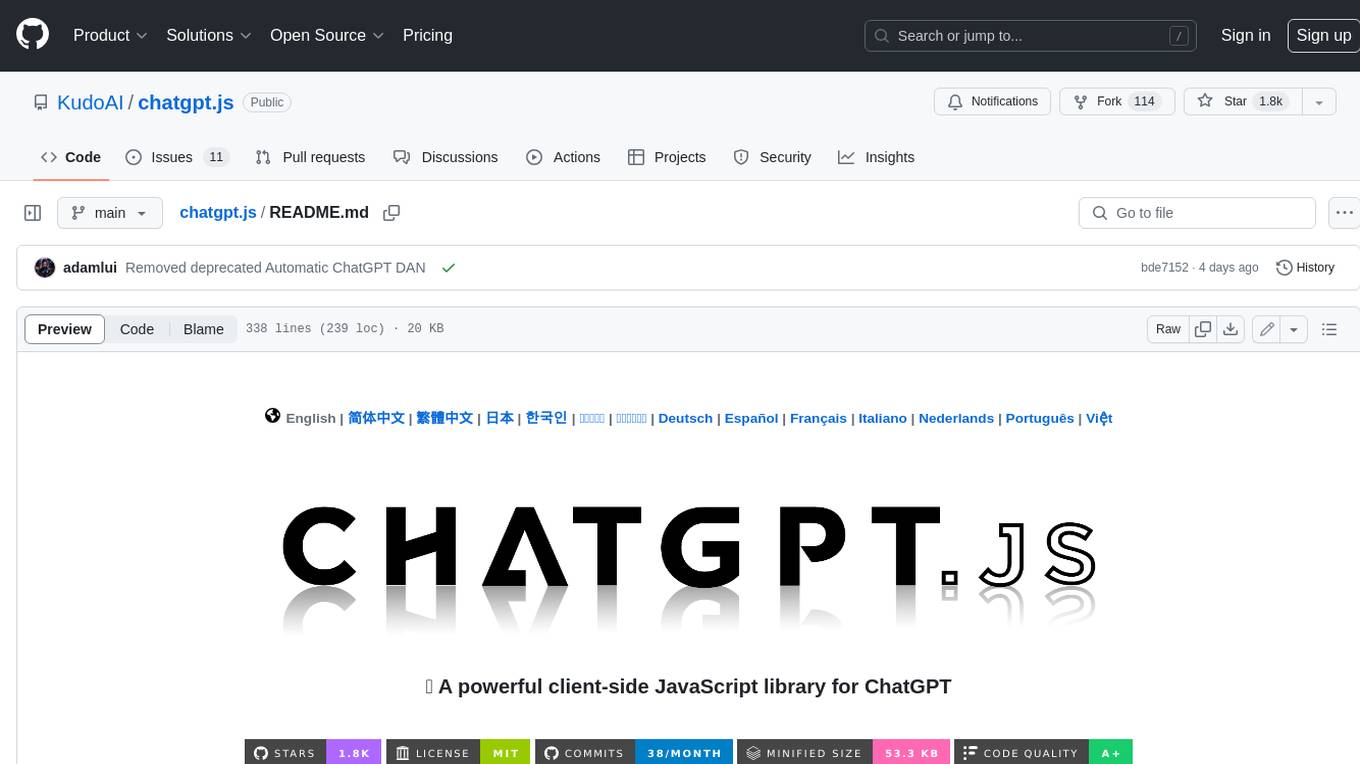
chatgpt.js
chatgpt.js is a powerful JavaScript library that allows for super easy interaction w/ the ChatGPT DOM. * Feature-rich * Object-oriented * Easy-to-use * Lightweight (yet optimally performant)

intel-extension-for-transformers
Intel® Extension for Transformers is an innovative toolkit designed to accelerate GenAI/LLM everywhere with the optimal performance of Transformer-based models on various Intel platforms, including Intel Gaudi2, Intel CPU, and Intel GPU. The toolkit provides the below key features and examples: * Seamless user experience of model compressions on Transformer-based models by extending [Hugging Face transformers](https://github.com/huggingface/transformers) APIs and leveraging [Intel® Neural Compressor](https://github.com/intel/neural-compressor) * Advanced software optimizations and unique compression-aware runtime (released with NeurIPS 2022's paper [Fast Distilbert on CPUs](https://arxiv.org/abs/2211.07715) and [QuaLA-MiniLM: a Quantized Length Adaptive MiniLM](https://arxiv.org/abs/2210.17114), and NeurIPS 2021's paper [Prune Once for All: Sparse Pre-Trained Language Models](https://arxiv.org/abs/2111.05754)) * Optimized Transformer-based model packages such as [Stable Diffusion](examples/huggingface/pytorch/text-to-image/deployment/stable_diffusion), [GPT-J-6B](examples/huggingface/pytorch/text-generation/deployment), [GPT-NEOX](examples/huggingface/pytorch/language-modeling/quantization#2-validated-model-list), [BLOOM-176B](examples/huggingface/pytorch/language-modeling/inference#BLOOM-176B), [T5](examples/huggingface/pytorch/summarization/quantization#2-validated-model-list), [Flan-T5](examples/huggingface/pytorch/summarization/quantization#2-validated-model-list), and end-to-end workflows such as [SetFit-based text classification](docs/tutorials/pytorch/text-classification/SetFit_model_compression_AGNews.ipynb) and [document level sentiment analysis (DLSA)](workflows/dlsa) * [NeuralChat](intel_extension_for_transformers/neural_chat), a customizable chatbot framework to create your own chatbot within minutes by leveraging a rich set of [plugins](https://github.com/intel/intel-extension-for-transformers/blob/main/intel_extension_for_transformers/neural_chat/docs/advanced_features.md) such as [Knowledge Retrieval](./intel_extension_for_transformers/neural_chat/pipeline/plugins/retrieval/README.md), [Speech Interaction](./intel_extension_for_transformers/neural_chat/pipeline/plugins/audio/README.md), [Query Caching](./intel_extension_for_transformers/neural_chat/pipeline/plugins/caching/README.md), and [Security Guardrail](./intel_extension_for_transformers/neural_chat/pipeline/plugins/security/README.md). This framework supports Intel Gaudi2/CPU/GPU. * [Inference](https://github.com/intel/neural-speed/tree/main) of Large Language Model (LLM) in pure C/C++ with weight-only quantization kernels for Intel CPU and Intel GPU (TBD), supporting [GPT-NEOX](https://github.com/intel/neural-speed/tree/main/neural_speed/models/gptneox), [LLAMA](https://github.com/intel/neural-speed/tree/main/neural_speed/models/llama), [MPT](https://github.com/intel/neural-speed/tree/main/neural_speed/models/mpt), [FALCON](https://github.com/intel/neural-speed/tree/main/neural_speed/models/falcon), [BLOOM-7B](https://github.com/intel/neural-speed/tree/main/neural_speed/models/bloom), [OPT](https://github.com/intel/neural-speed/tree/main/neural_speed/models/opt), [ChatGLM2-6B](https://github.com/intel/neural-speed/tree/main/neural_speed/models/chatglm), [GPT-J-6B](https://github.com/intel/neural-speed/tree/main/neural_speed/models/gptj), and [Dolly-v2-3B](https://github.com/intel/neural-speed/tree/main/neural_speed/models/gptneox). Support AMX, VNNI, AVX512F and AVX2 instruction set. We've boosted the performance of Intel CPUs, with a particular focus on the 4th generation Intel Xeon Scalable processor, codenamed [Sapphire Rapids](https://www.intel.com/content/www/us/en/products/docs/processors/xeon-accelerated/4th-gen-xeon-scalable-processors.html).
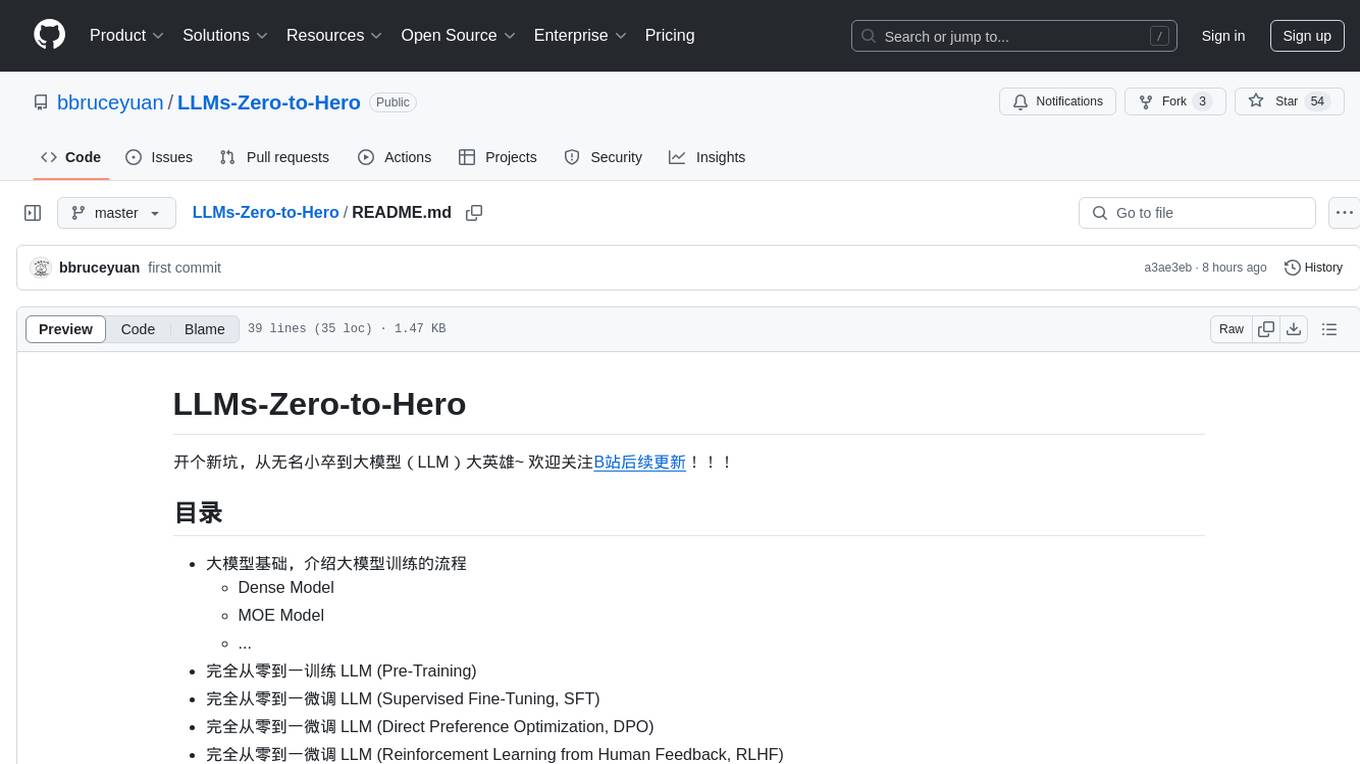
LLMs-Zero-to-Hero
LLMs-Zero-to-Hero is a repository dedicated to training large language models (LLMs) from scratch, covering topics such as dense models, MOE models, pre-training, supervised fine-tuning, direct preference optimization, reinforcement learning from human feedback, and deploying large models. The repository provides detailed learning notes for different chapters, code implementations, and resources for training and deploying LLMs. It aims to guide users from being beginners to proficient in building and deploying large language models.
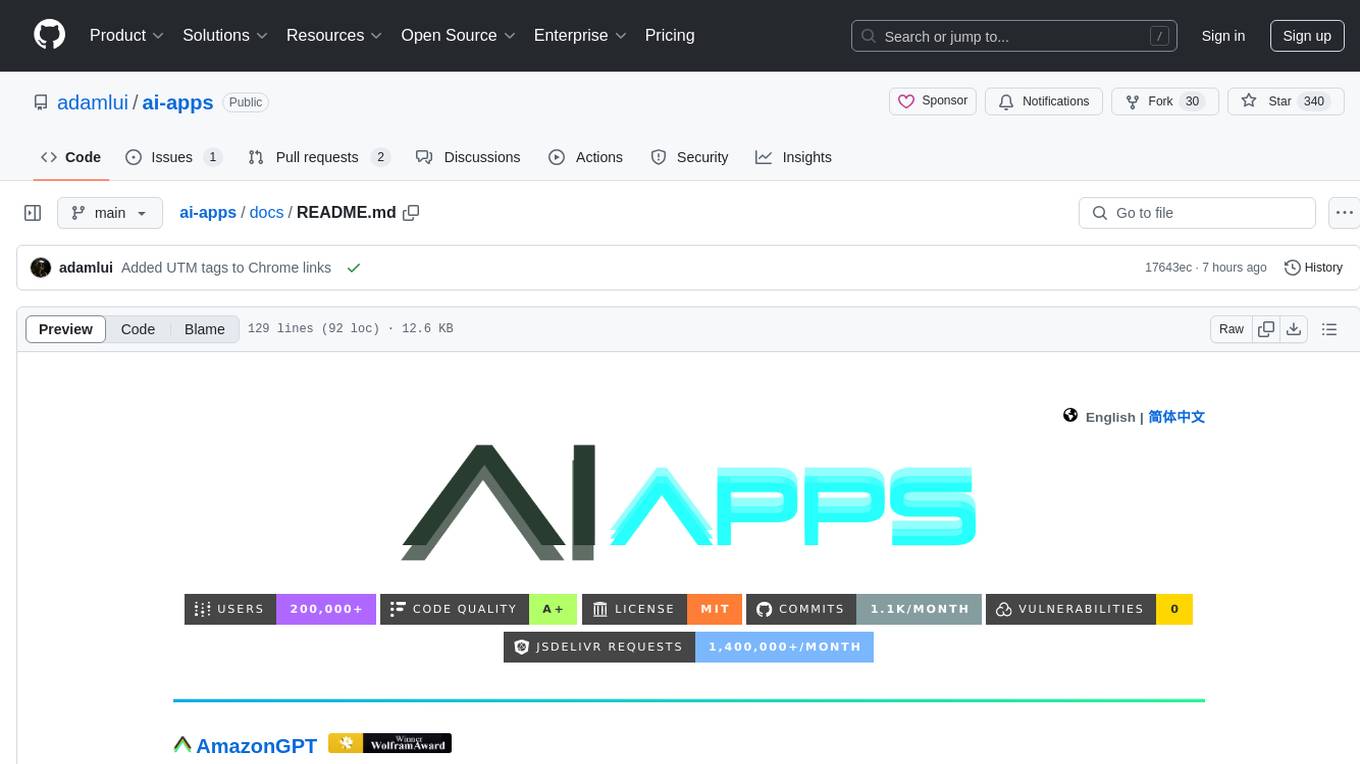
ai-apps
ai-apps is a collection of browser extensions that enhance various AI-powered services like Amazon shopping, Brave Search, ChatGPT, DuckDuckGo, and Google Search. These extensions provide functionalities such as adding AI answers to search engines, auto-clearing ChatGPT query history, auto-playing ChatGPT responses, keeping ChatGPT sessions fresh, and more. The repository offers tools to improve user experience and interaction with AI technologies across different platforms and services.
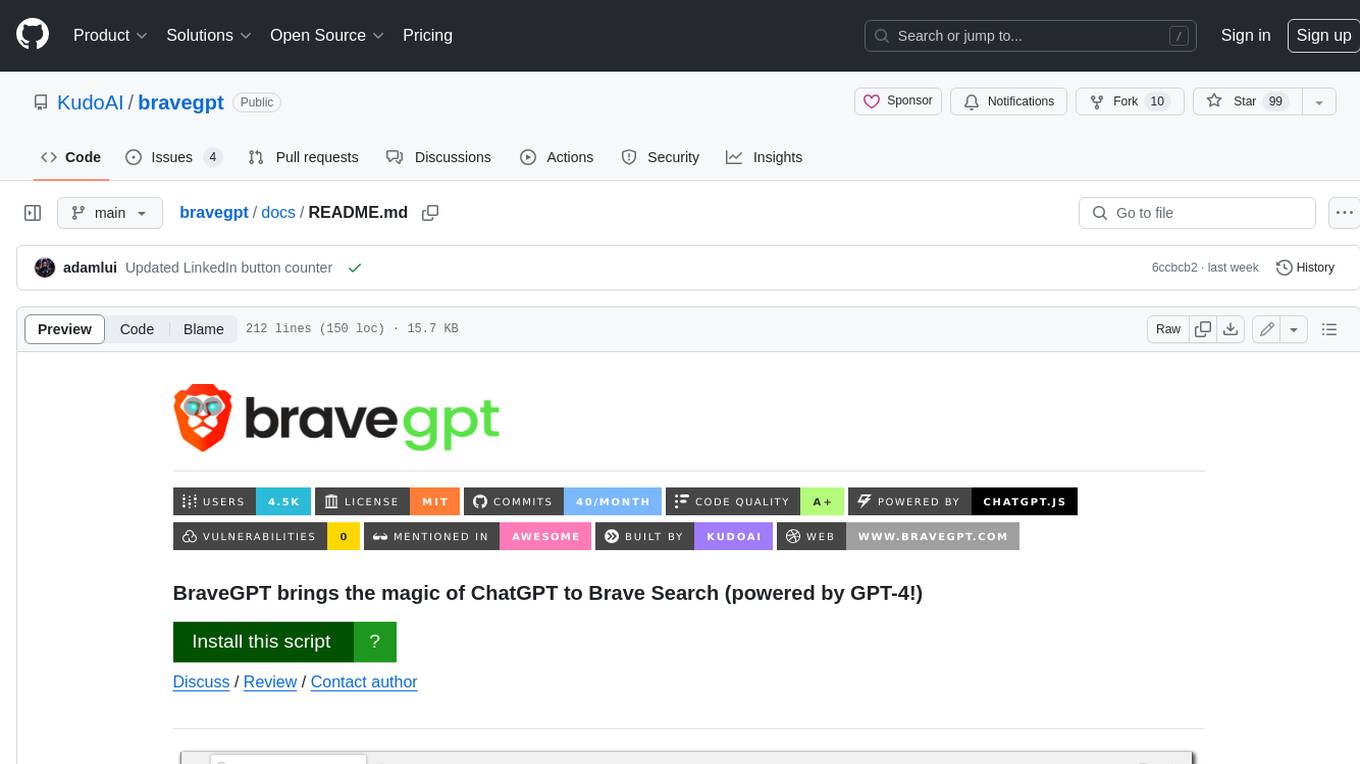
bravegpt
BraveGPT is a userscript that brings the power of ChatGPT to Brave Search. It allows users to engage with a conversational AI assistant directly within their search results, providing instant and personalized responses to their queries. BraveGPT is powered by GPT-4, the latest and most advanced language model from OpenAI, ensuring accurate and comprehensive answers. With BraveGPT, users can ask questions, get summaries, generate creative content, and more, all without leaving the Brave Search interface. The tool is easy to install and use, making it accessible to users of all levels. BraveGPT is a valuable addition to the Brave Search experience, enhancing its capabilities and providing users with a more efficient and informative search experience.
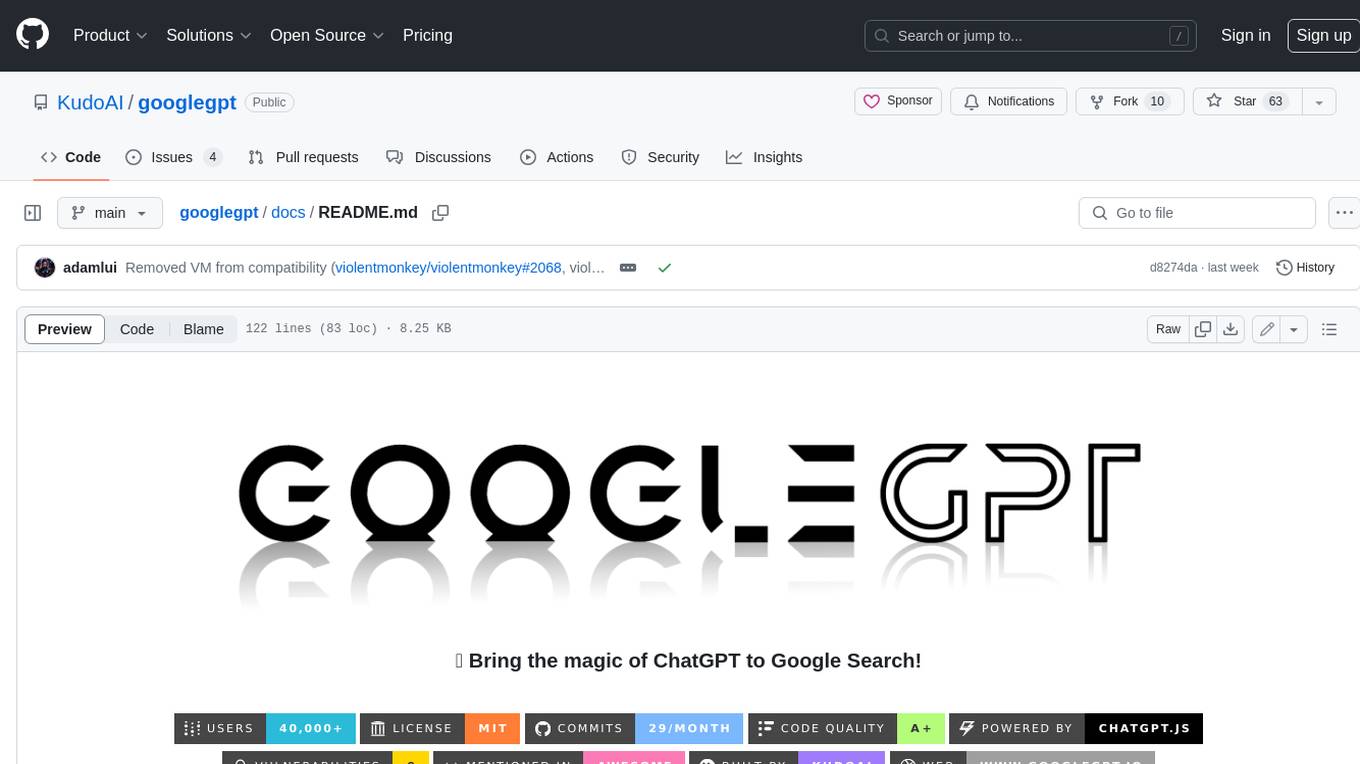
googlegpt
GoogleGPT is a browser extension that brings the power of ChatGPT to Google Search. With GoogleGPT, you can ask ChatGPT questions and get answers directly in your search results. You can also use GoogleGPT to generate text, translate languages, and more. GoogleGPT is compatible with all major browsers, including Chrome, Firefox, Edge, and Safari.
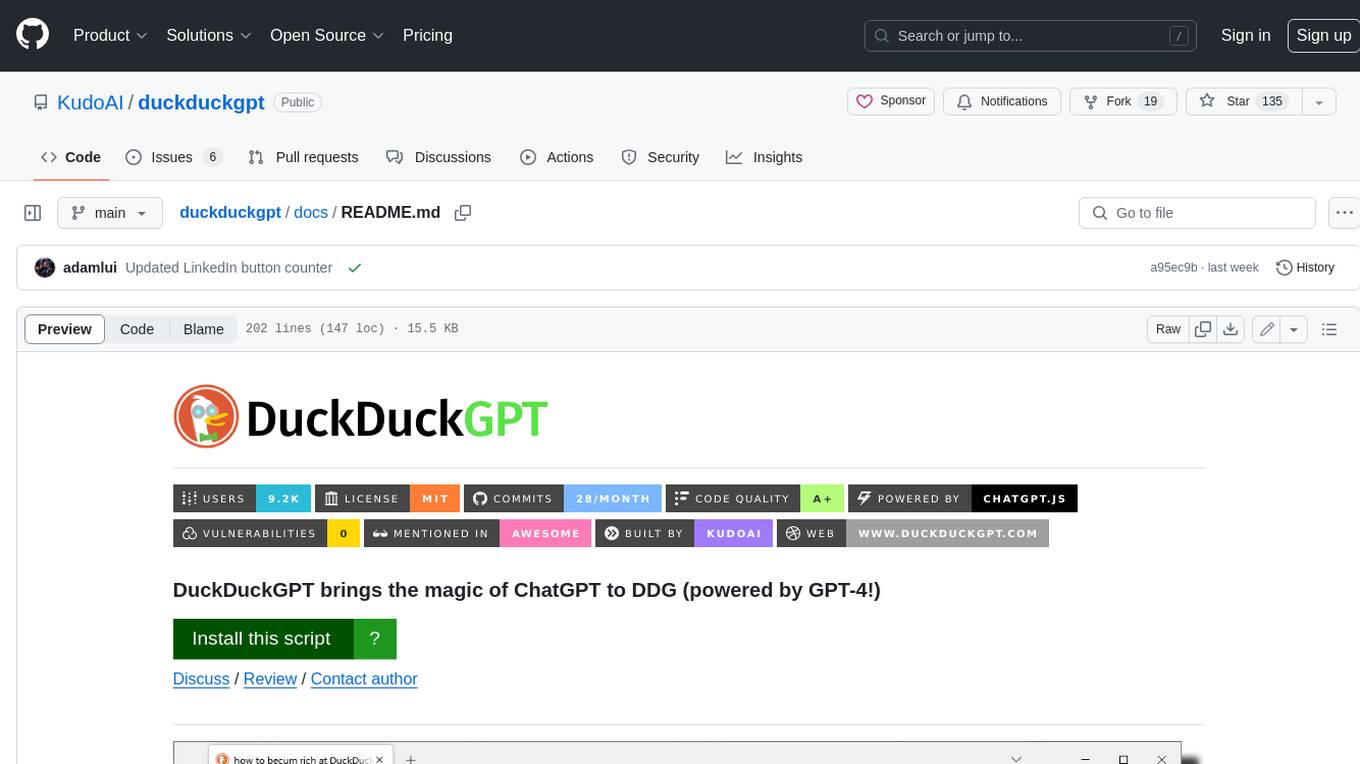
duckduckgpt
DuckDuckGPT brings the magic of ChatGPT to DDG (powered by GPT-4!). DuckDuckGPT is a browser extension that allows you to use ChatGPT within DuckDuckGo. This means you can ask ChatGPT questions, get help with tasks, and generate creative content, all without leaving DuckDuckGo. DuckDuckGPT is easy to use. Once you have installed the extension, simply type your question into the DuckDuckGo search bar and hit enter. ChatGPT will then generate a response that will appear below the search results. DuckDuckGPT is a powerful tool that can help you with a wide variety of tasks. Here are just a few examples of what you can use it for: * Get help with research * Write essays and other creative content * Translate languages * Get coding help * Answer trivia questions * And much more! DuckDuckGPT is still in development, but it is already a very powerful tool. As GPT-4 continues to improve, DuckDuckGPT will only get better. So if you are looking for a way to make your DuckDuckGo searches more productive, be sure to give DuckDuckGPT a try.
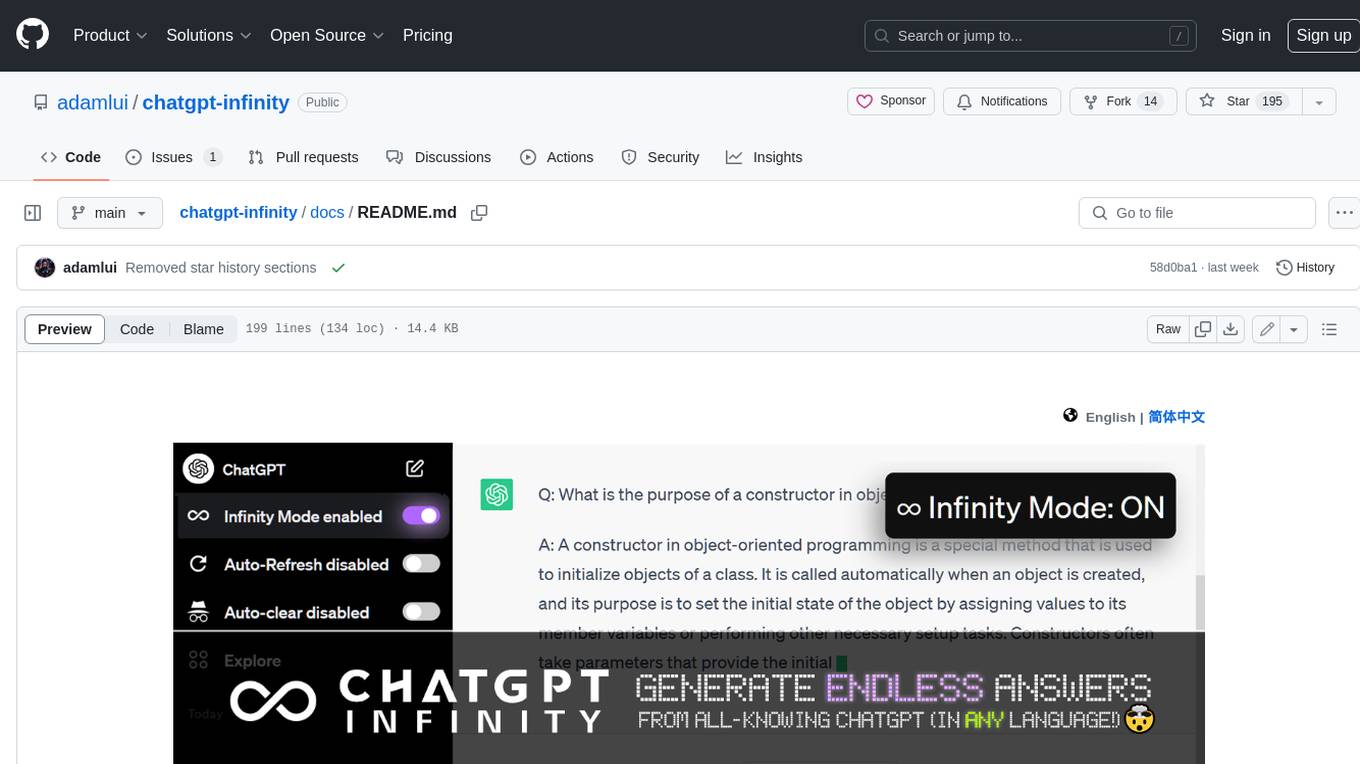
chatgpt-infinity
ChatGPT Infinity is a free and powerful add-on that makes ChatGPT generate infinite answers on any topic. It offers customizable topic selection, multilingual support, adjustable response interval, and auto-scroll feature for a seamless chat experience.
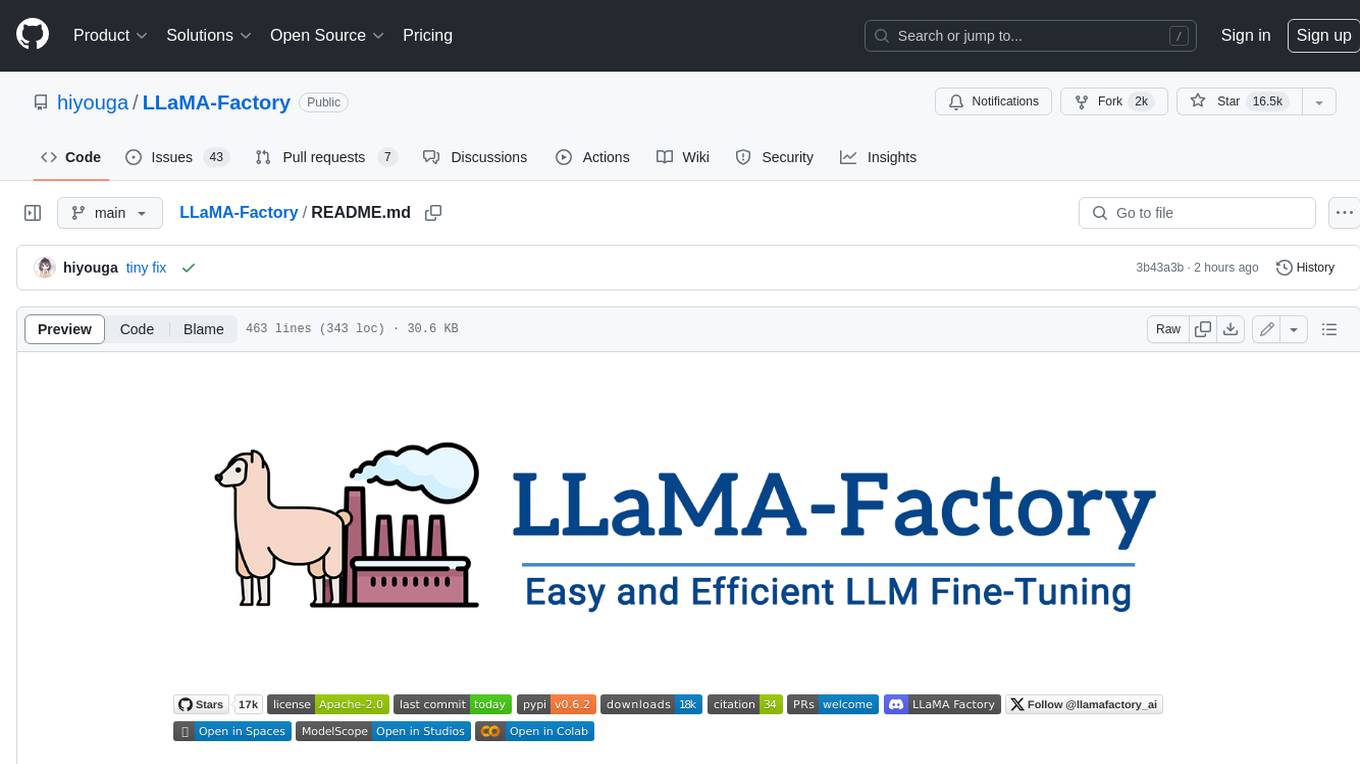
LLaMA-Factory
LLaMA Factory is a unified framework for fine-tuning 100+ large language models (LLMs) with various methods, including pre-training, supervised fine-tuning, reward modeling, PPO, DPO and ORPO. It features integrated algorithms like GaLore, BAdam, DoRA, LongLoRA, LLaMA Pro, LoRA+, LoftQ and Agent tuning, as well as practical tricks like FlashAttention-2, Unsloth, RoPE scaling, NEFTune and rsLoRA. LLaMA Factory provides experiment monitors like LlamaBoard, TensorBoard, Wandb, MLflow, etc., and supports faster inference with OpenAI-style API, Gradio UI and CLI with vLLM worker. Compared to ChatGLM's P-Tuning, LLaMA Factory's LoRA tuning offers up to 3.7 times faster training speed with a better Rouge score on the advertising text generation task. By leveraging 4-bit quantization technique, LLaMA Factory's QLoRA further improves the efficiency regarding the GPU memory.
For similar tasks
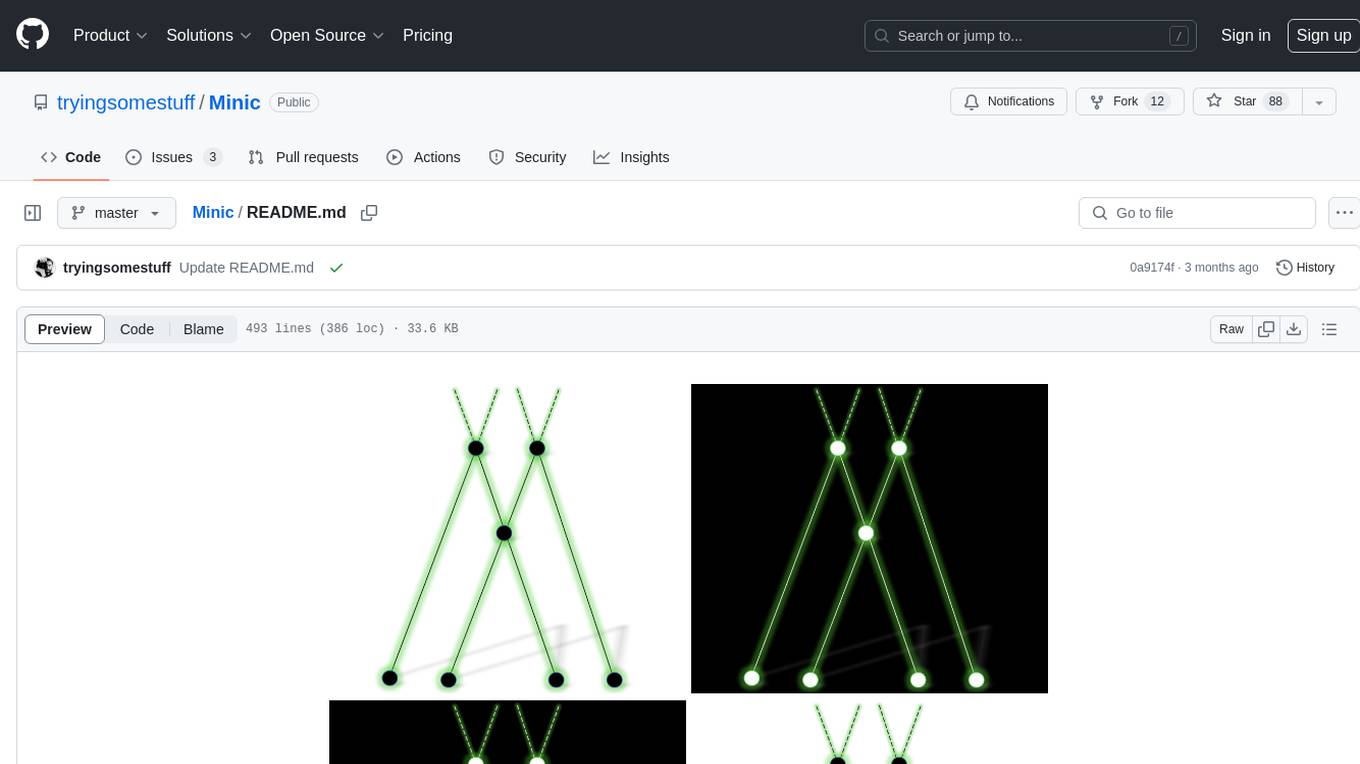
Minic
Minic is a chess engine developed for learning about chess programming and modern C++. It is compatible with CECP and UCI protocols, making it usable in various software. Minic has evolved from a one-file code to a more classic C++ style, incorporating features like evaluation tuning, perft, tests, and more. It has integrated NNUE frameworks from Stockfish and Seer implementations to enhance its strength. Minic is currently ranked among the top engines with an Elo rating around 3400 at CCRL scale.
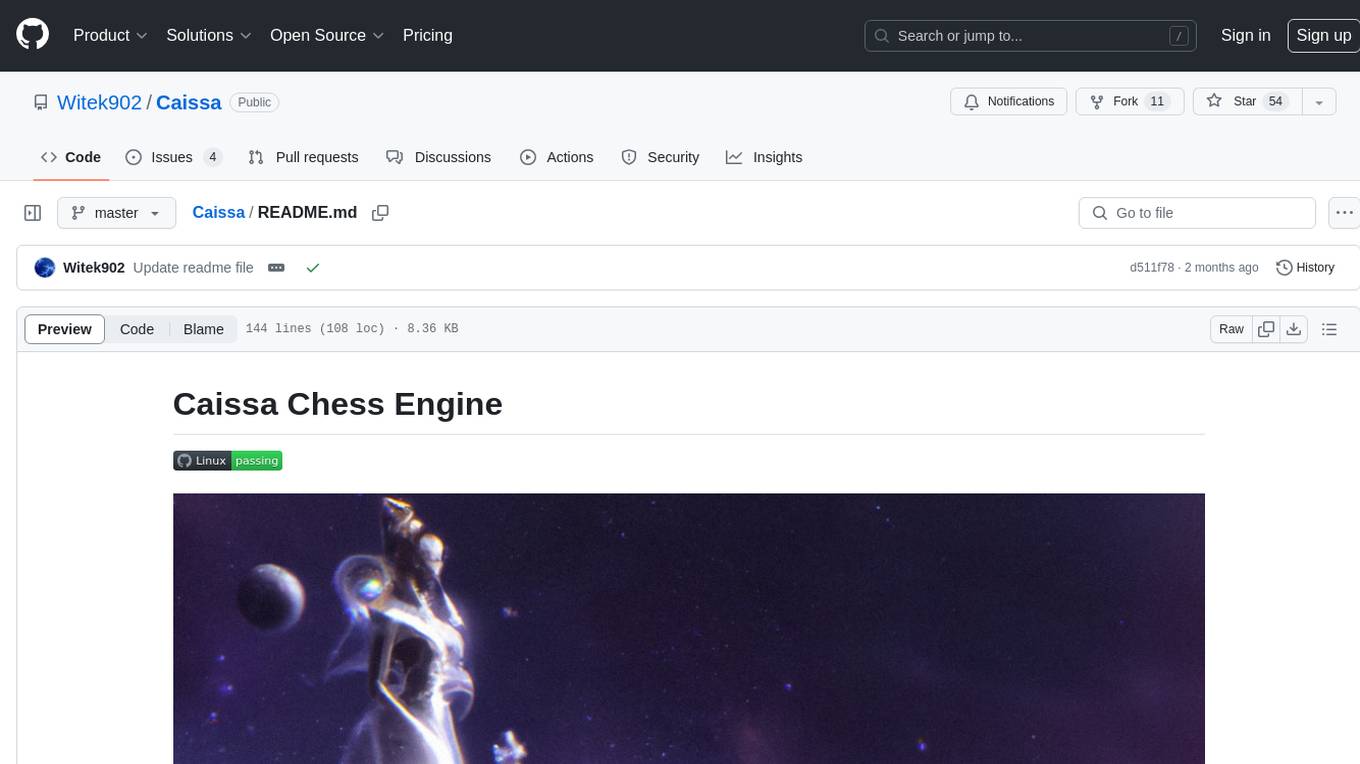
Caissa
Caissa is a strong, UCI command-line chess engine optimized for regular chess, FRC, and DFRC. It features its own neural network trained with self-play games, supports various UCI options, and provides different EXE versions for different CPU architectures. The engine uses advanced search algorithms, neural network evaluation, and endgame tablebases. It offers outstanding performance in ultra-short games and is written in C++ with modules for backend, frontend, and utilities like neural network trainer and self-play data generator.

eleeye
ElephantEye is a free Chinese Chess program that follows the GNU Lesser General Public Licence. It is designed for chess enthusiasts and programmers to use freely. The program works as a XiangQi engine for XQWizard with strong AI capabilities. ElephantEye supports UCCI 3.0 protocol and offers various parameter settings for users to customize their experience. The program uses brute-force chess algorithms and static position evaluation techniques to search for optimal moves. ElephantEye has participated in computer chess competitions and has been tested on various online chess platforms. The source code of ElephantEye is available on SourceForge for developers to explore and improve.
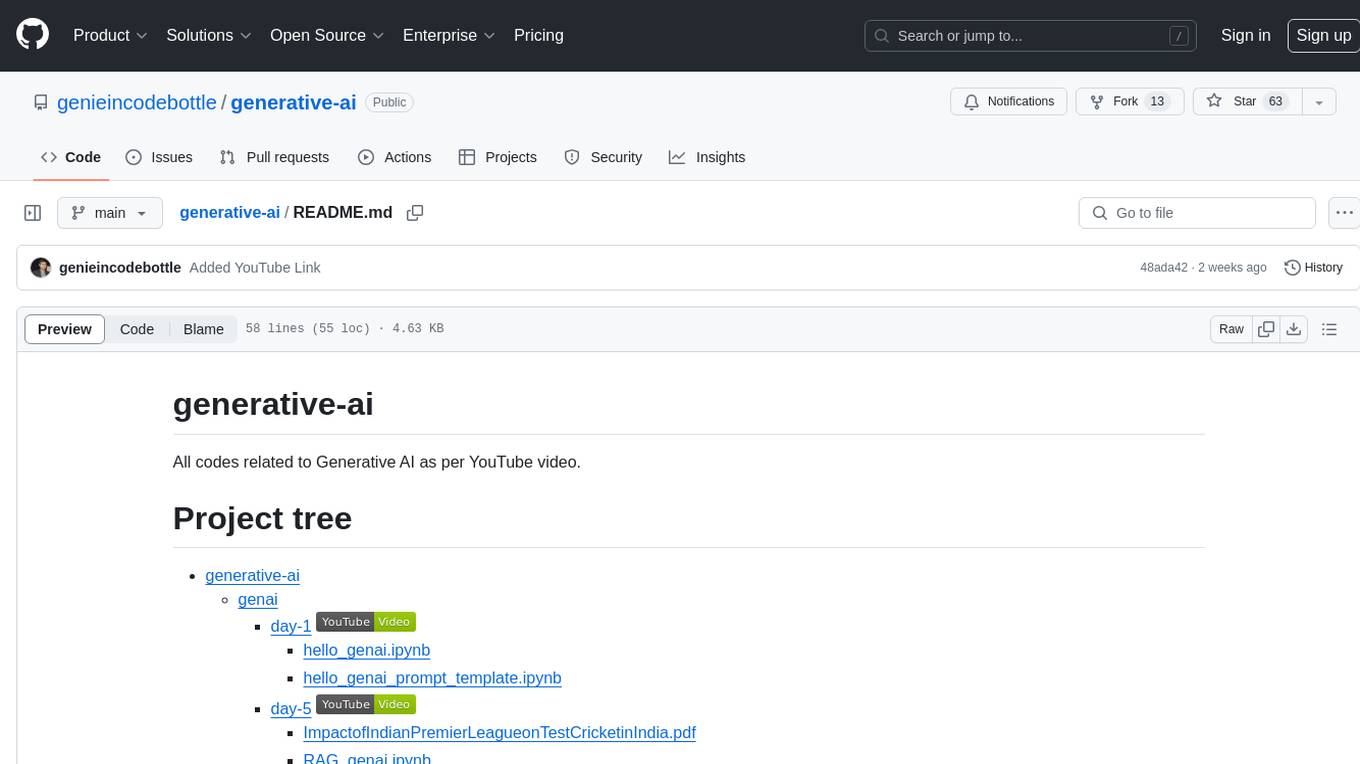
generative-ai
This repository contains codes related to Generative AI as per YouTube video. It includes various notebooks and files for different days covering topics like map reduce, text to SQL, LLM parameters, tagging, and Kaggle competition. The repository also includes resources like PDF files and databases for different projects related to Generative AI.
For similar jobs

sweep
Sweep is an AI junior developer that turns bugs and feature requests into code changes. It automatically handles developer experience improvements like adding type hints and improving test coverage.

teams-ai
The Teams AI Library is a software development kit (SDK) that helps developers create bots that can interact with Teams and Microsoft 365 applications. It is built on top of the Bot Framework SDK and simplifies the process of developing bots that interact with Teams' artificial intelligence capabilities. The SDK is available for JavaScript/TypeScript, .NET, and Python.

ai-guide
This guide is dedicated to Large Language Models (LLMs) that you can run on your home computer. It assumes your PC is a lower-end, non-gaming setup.

classifai
Supercharge WordPress Content Workflows and Engagement with Artificial Intelligence. Tap into leading cloud-based services like OpenAI, Microsoft Azure AI, Google Gemini and IBM Watson to augment your WordPress-powered websites. Publish content faster while improving SEO performance and increasing audience engagement. ClassifAI integrates Artificial Intelligence and Machine Learning technologies to lighten your workload and eliminate tedious tasks, giving you more time to create original content that matters.

chatbot-ui
Chatbot UI is an open-source AI chat app that allows users to create and deploy their own AI chatbots. It is easy to use and can be customized to fit any need. Chatbot UI is perfect for businesses, developers, and anyone who wants to create a chatbot.

BricksLLM
BricksLLM is a cloud native AI gateway written in Go. Currently, it provides native support for OpenAI, Anthropic, Azure OpenAI and vLLM. BricksLLM aims to provide enterprise level infrastructure that can power any LLM production use cases. Here are some use cases for BricksLLM: * Set LLM usage limits for users on different pricing tiers * Track LLM usage on a per user and per organization basis * Block or redact requests containing PIIs * Improve LLM reliability with failovers, retries and caching * Distribute API keys with rate limits and cost limits for internal development/production use cases * Distribute API keys with rate limits and cost limits for students

uAgents
uAgents is a Python library developed by Fetch.ai that allows for the creation of autonomous AI agents. These agents can perform various tasks on a schedule or take action on various events. uAgents are easy to create and manage, and they are connected to a fast-growing network of other uAgents. They are also secure, with cryptographically secured messages and wallets.

griptape
Griptape is a modular Python framework for building AI-powered applications that securely connect to your enterprise data and APIs. It offers developers the ability to maintain control and flexibility at every step. Griptape's core components include Structures (Agents, Pipelines, and Workflows), Tasks, Tools, Memory (Conversation Memory, Task Memory, and Meta Memory), Drivers (Prompt and Embedding Drivers, Vector Store Drivers, Image Generation Drivers, Image Query Drivers, SQL Drivers, Web Scraper Drivers, and Conversation Memory Drivers), Engines (Query Engines, Extraction Engines, Summary Engines, Image Generation Engines, and Image Query Engines), and additional components (Rulesets, Loaders, Artifacts, Chunkers, and Tokenizers). Griptape enables developers to create AI-powered applications with ease and efficiency.